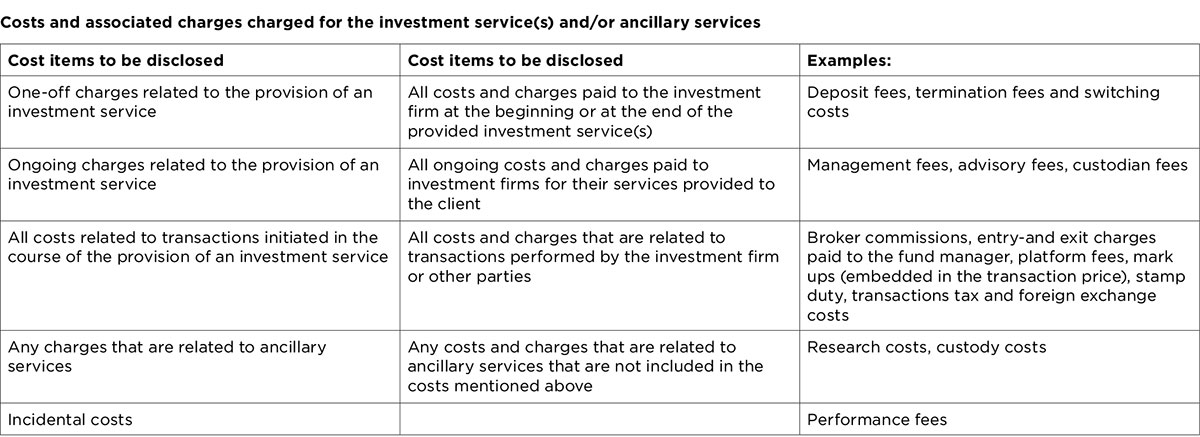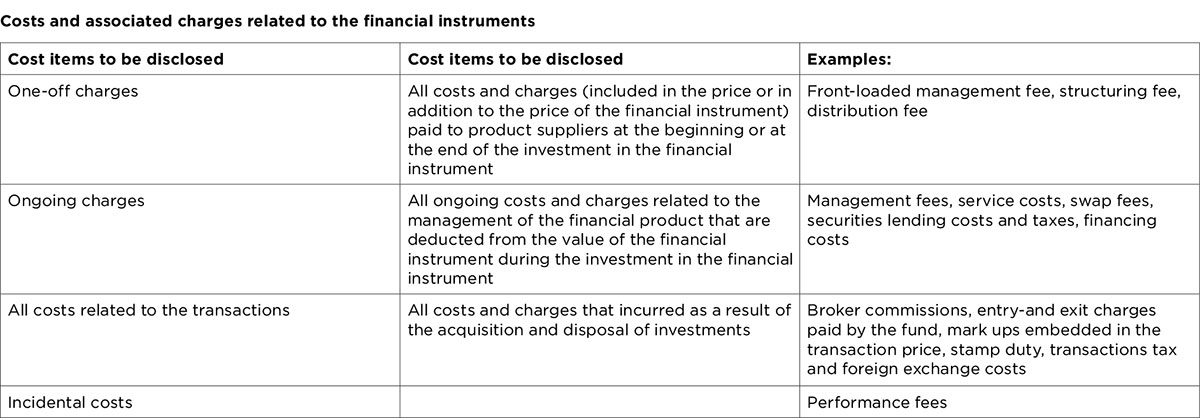The second iteration of the Markets in Financial Instruments Directive (MiFID II) took effect on 3 January 2018, yet the markets are still grappling with how best to comply with its requirements on disclosure of costs and charges. With the first set of annualised statements starting to be sent out to clients and their advisers at the turn of the year, those receiving them are saying that they can vary widely in their scope and presentation.
This is because, although MiFID II has prescribed what needs to be reported, the way in which it is to be presented has been left to individual firms to decide. Each firm is doing what they think they should do, but they are not sharing their methodologies.
“The MiFID II costs and charges disclosure rules have been handed down by the EU to the FCA, and the regulator has resisted calls for any form of disclosure template,” explains Mike Phillips, compliance and risk manager at Equilibrium Asset Management.
“The result of this is that firms are having to find their own standards and ways of complying, with varying results. Over time, expect to see increased uniformity as firms share best practice, but the short-term picture is likely to result in confusion for clients. This could mean that, in the short term, the implementation of the rules runs counter to the objective of increasing customer transparency and encouraging comparison.”
The European regulator, the European Securities and Markets Authority (ESMA), states that the MiFID II legislative framework will “strengthen investor protection and improve the functioning of financial markets, making them more efficient, resilient and transparent”. A key component of this transparency involves clarifying to clients – both wholesale and retail investors – what costs and charges they stand to pay, enabling them to compare offerings from different providers to assess which provides the best value for money.
Will this give clients greater clarity or simply create confusion? Gerhard Greuter, managing director of Lawson Conner, a firm that supplies regulatory infrastructure and managed compliance services and software, says that the lack of a standardised template will confuse customers. There could also be additional confusion arising from the differing reporting periods that firms may use in providing information to their clients. Some, for example may prefer January to January reporting, whereas others may prefer to align with their customers’ reporting periods.
"The lack of a standardised template and differing reporting periods will confuse customers"
Robert Lockie CFPTM Chartered FCSI, investment manager and branch principal at Bloomsbury Wealth, says that disclosure is a good thing and that it will take clients time to appreciate this. However, he says that the costs and charges calculations he has encountered have varied widely. “Consumers will be confused [by MiFID II reporting]. Getting multiple statements from multiple providers will confuse them further, as will the fact that some providers give a separate statement for each product.”
Gerhard adds: “When deciding which reporting formats to use, customer feedback will be key – ultimately retail customers will only derive benefit from the directive if they find the information easy to understand and that is what firms need to verify.”
In a white paper published October 2017, Western Asset Management Company states that overall, MiFID II should be a “positive event” for its clients. One of the main areas for client consideration is investor protection. The paper says: “The investor protection element of MiFID II will enable our clients to receive more information about their investments on a periodic basis. In addition to trade and holdings data, clients will be receiving costs and charges information relating to their portfolios. This is a new concept for fixed-income asset managers and the industry is working on developing an appropriate standard. The costs and charges reports will be provided to clients on an annual basis.
In order to drive transparency, the framework to be implemented in the EU member states is both prescriptive and extensive. Described in Article 24(4) of MiFID II and Article 50 of the Delegated Regulation, firms providing investment services are required to set out their costs and charges before they trade (ex-ante) and afterwards (ex-post). These must include those relating to trading financial instruments, for example costs of executions; those arising from related services that are provided, for example paying for external research; and any payments they may have otherwise received in relation to the services provided.
Supply side firms must provide an illustrative report that shows the costs and charges as a percentage and cash amount. On both ex-ante and ex-post bases, they must show the impact on their clients’ returns on investment, any fluctuations in costs and include a written explanation of their illustration.
Additionally, firms must respond to client requests for itemised disclosures of costs and charges. These must be broken down into various categories, five relating to ancillary services and four for trading in financial instruments – see boxouts at end. A client can request such data at any time. Firms must also provide clients with annual statements of aggregated costs and charges.
Far-reaching scope According to the FCA, MiFID II’s scope is far-reaching. Its requirements apply to “firms providing investment services (such as investment advice) to clients relating to MiFID financial instruments (such as shares, bonds, units in collective investment schemes, and derivatives)”. Some requirements also apply to firms when they sell or advise clients on structured deposits, as well as “venues where financial instruments are traded”.
Knowing whether a firm falls within scope is relatively easy; implementation has proved to be less so. According to PwC in a May 2018 research paper, investment firms have spent a significant amount of time and resources implementing MiFID II costs and charges requirements.
“It has proven to be one of the more complex and challenging areas of the MiFID II regulations from both a commercial and technology point of view, given the number of touch points with business processes across most asset classes, and the need to balance the risk of disclosing too much to clients yet respecting new regulatory requirements,” says the research paper.
MethodologiesThe challenge facing advisers and wealth managers is the vast amount of information they receive from different providers, which can be difficult to collate on behalf of clients. While the markets are still digesting guidance from ESMA issued on 28 March 2019, it does not contain all the potential answers arising from this new, highly complex and largely untried guidance.
Here are some useful starting points:
- Ex-post reporting of total costs and charges is to be on an annual basis, though investment firms may choose to provide it more frequently. Investment firms are to express them as a percentage of the portfolio, fund or trade and as a cash amount. There is also some good news for those already familiar with the Packaged Retail and Insurance-based Investment Products (PRIIPs) Regulation. The ESMA Q&A explains that the PRIIPs key information documents (KIDs) “cover all cost components, so that an investment firm can fulfil its obligation under the MiFID II regime with regard to the ex-ante costs and charges of a financial instrument”.
- Employing the same methodology for an ex-post calculation would be consistent and understandable for a client. As ex-post costs and charges have already been incurred, they are likely to be correct, versus extrapolation before transactions have actually taken place in any reporting period.
- PRIIPS does not hold all the answers. First, the products or services in question may not be packaged products. Second, the products or services may not be offered to retail investors. The ESMA Q&A says that the PRIIPS methodology would not apply to non-packaged retail products, although for those such as alternative investment funds for example, offered only to professional clients, it could.
- The availability of third-party data from product manufacturers continues to be an issue for advisers and clients, especially as they do not necessarily disclose the same information in the same way. Investment firms, says ESMA, should use the PRIIPS methodology if possible, but otherwise they should assure themselves that it can make “a reasonable and sufficiently accurate estimate of the total costs of the financial instrument”.
- Product manufacturer’s costs and charges are different from those of investment firms themselves. The ESMA guidance on aggregated costs and charges seems to be straightforward. It provides the following table in respect of a €100,000 portfolio, which details three categories of costs and charges: those relating to investment and/or ancillary services; third-party payments received; and those to do with financial instruments, all shown by cash and as a percentage. ESMA adds that itemised breakdowns of these numbers are to be made available at the client’s request.
 Source: ESMA's Questions and answers on MiFID II and MiFIR investor protection and intermediaries topics
Source: ESMA's Questions and answers on MiFID II and MiFIR investor protection and intermediaries topics
Clear path ahead?
PwC’s research examines 32 supply side banks that provide investment products and services. The firms surveyed prioritise producing annual statements to a level that they deem appropriate, often leaving major IT enhancements until further guidance has been received.
“Although some firms have refined their approach since MiFID II go-live on 3 January 2018, we have found that this remains in flux, as firms have been awaiting further regulatory guidance,” says PwC. “However, the publication of the ESMA Q&A covering costs and charges issued on 28 March 2019 has prompted firms to review whether their approach is appropriate.”
Now that the ESMA guidance has been issued, there should be fewer concerns among both clients and their providers. However, as this has only recently been issued, it’s difficult to know if challenges will persist for clients receiving the full information in a format that enables them to compare both ex-ante and ex-post data.
Categories and costs

 Source: Annex II of the Delegated Regulation
Source: Annex II of the Delegated Regulation
Seen a blog, news story or discussion online that you think might interest CISI members? Email bethan.rees@wardour.co.uk.